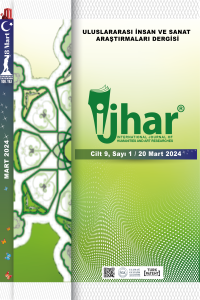Öz
Metal, sanayinin birçok alanında hem ambalaj hem de üretim malzemesi olarak yoğun kullanılır. Özellikle ambalaj sanayisinde; endüstriyel yağ, boya vb. kimyasal maddelerin kutularının, iki ve üç parçalı konserve, salca, yağ, peynir vb. gıda kutularının, içecek kutularının, kavanoz, meşrubat ve kolay açılır kapakların, aerosol kutularının, dekoratif kutuların, oyuncak ve kırtasiye gereçleri gibi birçok endüstriyel ürünün ambalajlamasında önemli avantajlar sağlar.
Günümüzde altın ve gümüş dışında hemen her metal, ambalaj sanayinde kullanılmaktadır. Metal kutu üretiminde en çok kullanılan malzeme şüphesiz çeliktir. Farklı tip çelik levhalardan üretilen metal kutular, çeşitli ürünlerin ambalajı olarak kullanılır. Metalin en fazla kullanılan ikinci türü olan alüminyum hem gazlı hem de gazsız içeceklerin ambalajı olarak kullanılır. Aynı şekilde işlenmiş gıda maddelerini korumak, alüminyum malzemeli ambalajların zor işlerinden biridir. Metal ambalajlar, metalin türüne bakmaksızın bu konuda avantajlı konumdadır. Çünkü metal ambalajlar; oksijeni, rutubeti ve ışığı yüzde yüz oranında tutar. Aynı zamanda dış parazitlerin içeri girmesini mutlak suretle engelleyebilir yapıdadır. Bu açıdan metalin her türünün güvenli olması, altın ve gümüş gibi metallerin kullanılmasına ihtiyaç bırakmamaktadır. Zaten böylesine değerli metallerin, özel yapım veya sipariş dışında kullanılması, yatırımcısı için ekonomik olmayabilir.
Bu makale ile metalin ambalaj olarak günlük yaşantıda yeri ve önemi araştırılmıştır. Özellikle de gıda gibi hassas sektörde metal ambalaj, çoğu zaman can simidi olabilir. Öyle ki gıda sektöründe metal ambalaj, ürünün sadece sağlıklı korunmasını sağlamakla kalmaz, onun uzun vadede saklanmasında da büyük avantaj sağlar. Bu makale ile gıda ambalajlamasında önemli bir malzeme haline gelen metal ambalajın kısa tarihi, gelişim süreci, gıda sektöründeki yeri araştırılmış ve örneklendirilmiştir. Metal ambalajın özellikle gıda sektöründe neden tercih edildiği, ne tür avantajları olduğu ve ambalaj öncesinde nasıl bir sağlık önlemine tabi olduğu anlatılmıştır.
Anahtar Kelimeler
Kaynakça
- Arıkan, A. (2011). Metal Ambalajlar. ASD Ambalaj Bülteni. ? (46), 36-40.
- ASD Bülteni (2024). Metal Ambalajda Bonapart Öncülüğü. https://ambalaj.org.tr/tr/ambalaj-ve-cevre-ambalajin-tarihcesi. ET. 10.03.2024
- Baltacı, A. (2019). Nitel Araştırma Süreci: Nitel Bir Araştırma Nasıl Yapılır? Ahi Evran Üniversitesi Sosyal Bilimler Enstitüsü Dergisi, 5 (2), 368-388.
- Dainelli, D., Gontard, N., Sypropoulos, D., Zodervan-Van B. E. and Tobback, B.A. (2008). Active and intelligent food packaging: legal aspects and safety concerns. Trends in Food Science & Technology, 19 (28), 103-112.
- Dobrucka, R. & Ankiel, M. (2018). Possible Applications of Metal Nanoparticles in Antimicrobial Food Packaging. Journal Food Safety Wiley. 39 (2), 1-7. DOI: https://doi.org/10.1111/jfs.12617
- Duran, A., Tüzen, M. & Soylak, M. (2013). Evaluation of Metal Concentrations in Food Packaging Materials: Relation to Human Health. 34 (3), 99-103.
- Elisah, C. (2022). Metal Ambalaj Kullanmanın 5 Avantajı. https://tinsbymasas.com/blogs/news/metal-ambalaj-kullanmanin-5-avantaji. E.T. 11.03.2024
- Erdal, G. (2021). Metal And Metal Packaging (1. Baskı). Sentez Pulishing. ISBN 978-625-7906-22-7
- Hansen, A.P., Serin, G. (1999). Materials and strategies for successful innovation and competition in the metal packaging industry. Pergamon Technology in Society, 21 (99), 307-322.
- Hoseinnejad, M., Jafari, S. M. & Katouzian , I. (2018) Inorganic and metal nanoparticles and their antimicrobial activity in food packaging applications. Critical Reviews in Microbiology, 44 (2), 161-181, DOI: 10.1080/1040841X.2017.1332001
- Koçak, F. (1991). İlaç Endüstrisinde Kullanılan Ambalaj Malzemesi. T.C. Uludağ Üniversitesi Fen Edebiyat Fak. Kimya Bölümü, Bitirme Çalışması.
- Kumar, A., Choudhary, A., Kaur, H., Mehta, S. and Husen, A. (2021). Metal-based nanoparticles, sensors, and their multifaceted application in food packaging. Journal of Nanobiotechnology. 19 (1), 1-25. DOI: https://doi.org/10.1186/s12951-021-00996-0
- Luciano, P., Lumbo, S. (2016). Food Packaging Materials. New York Dordrecht. Springer Cham Heidelberg.
- Marsh, K., Bugusu, B. (2007). Food Packaging—Roles, Materials, and Environmental Issues. Journal Of Food Science. 72(3), 39-55. https://doi.org/10.1111/j.1750-3841.2007.00301.x
- MEGEP (2011). Metal Teknolojisi. Milli Eğitim Bakanlığı, Doğrultma 521MMI038
- Patel, J., Sand, C.K. (2020). The Role of Metal in Food Packaging. Foud Technology, 77-80.
- Robertson, G. L. (2013). Food Packaging Principles and Practice. Boca Raton London New York: CRC. Press Taylor & Francis Group.
- Saka, E. G. (2015). Gıda Teknolojisinde Nanoteknoloji Uygulamaları. Etlik Veteriner Mikrobiyoloji Dergisi, 26 (2), 52-57. DOI: https://doi.org/10.35864/evmd.513387
- Sak, R., Şahin Sak, İ. T., Öneren Şendil, Ç., Nas, E. (2021). Bir araştırma yöntemi olarak doküman analizi. Kocaeli Üniversitesi Eğitim Dergisi, 4(1), 227-250. DOI:http://doi.org/10.33400/kuje.843306
- Siracusa, V. (2016). Packaging Material in the Food Industry. Antimicrobial Food Packaging (Chapter 7, 95-106). Elsevier Inc. All rights reserved.
- Thomas, H. (1995). The Total Package: The Evolution and Secret Meanings of Boxes, Bottles, Cans and Tubes. New York: Little, Brown.
- Özek, E. U. (2016)). Ambalaj Sektörü TRB1. Fırat Kalkınma Ajansı.
- Özkaya, B. (?). Gıda Ambalajlama (GDM-304). Ankara Üniversitesi Açık Ders Malzemeleri. https://acikders.ankara.edu.tr/pluginfile.php/56745/mod_resource/content/0/1.%20GIDA%20AMBALAJLAMA.pdf
- TOBB. ( 2011). Alüminyum Sanayi Meclis Sektör Raporu. Türkiye Odalar ve Borsalar Birliği.
- Weissbach, W. (1993). Malzeme Bilgisi ve Muayenesi (6. Baskı). Birsen Yayınları.
- Wikipedia (2024). Metal. https://tr.wikipedia.org/wiki/Metal, E.T. 10.03.2024.
- Voon, C.H., Foo, K.L., Lim, B.Y., Gopinath, S.C.B. and Al-Douri, Y. (2020). Chemical studies of metal oxide powders. Metal Oxide Powder Technologies (1st Edition), (Captur 3, 31-54). Elsevier publications
- Yıldız, F., Kunter, İ. (2013). XII. Ambalajlı Ürünlerde Raf Ömrü Hesaplamaları. ODTÜ Gıda Ambalaj Malzemeleri Araştırma Raporu. ODTÜ Yayınları.
Öz
Packaging materials used in the food industry have various shapes and a wide range of functions. Selection of the most suitable packaging depends on many factors, especially the type of food that needs to be protected. In this sense, it can be said that significant progress has been made in food packaging in recent years and that metal packaging has made a significant contribution. In their simplest definition, metals are chemical elements with "metallic properties" or "metals properties." Such chemical elements include luster, thermal structure, electrical conductivity, high thermal conductivity, crystal structure, magnetization, and the ability to be permanently shaped or deformed at room temperature. There are many types of metals, even in their most typical forms. Metal is widely used as packaging and production material in many areas of industry. Especially in the packaging sector: industrial oil, paint, chemical substance boxes, two and three-piece canned food, tomato paste, oil, cheese, etc. Packaging many industrial products, such as food and beverage cans, provides significant advantages. The food packaging system emerged due to increasing global foodborne epidemics and related health and safety concerns. In this sense, packaging technology is essential to have information about the environment in which the shelf life of food products must be extended to optimize the entire packaging system because the structure and material of the packaging play an important role in determining the life of the food. The correct selection of packaging materials and technologies preserves the product's quality and freshness during distribution and storage. Among the materials traditionally used in food packaging, metals (aluminum, foils and laminates, tinplate, and tin-free steel) come first. Biobased packaging materials have a lower environmental impact than petroleum-based materials. Still, their properties must be well formulated to encourage industry use so much that packaging requires information about available materials, food, distribution system, shelf life, and environmental impact.
Almost the majority of materials used in food packaging are metals. Elements used in food packaging are used in very pure form (aluminum) and metal alloys (steel, tinplate). Therefore, the production of food packaging products starts from mined ores and then refined to extract the metal. The initial concentration of the mineral and how it is formed will directly affect the costs associated with the final material.
The most commonly used metals include elements and alloys such as aluminum, copper, steel, silver, brass, bronze, lead, tin, zinc, and gold. Almost every metal except gold and silver is used in the packaging industry. The most commonly used material in metal can production is undoubtedly steel. Metal boxes produced from different types of steel sheets are used as packaging for various products. Aluminum is used in the packaging of both carbonated and still beverages. Protecting processed food items is both a priority and a difficult task in terms of packaging. Regardless of the type of metal, metal packaging is advantageous in this regard. Metal packaging protects 100 percent oxygen, moisture, and light. It also has a structure that can prevent the entry of external parasites. In this regard, the safety of all kinds of metal eliminates the need to use gold and silver. Using precious metals other than those initially produced or ordered may not be economical for the investor.
Anahtar Kelimeler
Kaynakça
- Arıkan, A. (2011). Metal Ambalajlar. ASD Ambalaj Bülteni. ? (46), 36-40.
- ASD Bülteni (2024). Metal Ambalajda Bonapart Öncülüğü. https://ambalaj.org.tr/tr/ambalaj-ve-cevre-ambalajin-tarihcesi. ET. 10.03.2024
- Baltacı, A. (2019). Nitel Araştırma Süreci: Nitel Bir Araştırma Nasıl Yapılır? Ahi Evran Üniversitesi Sosyal Bilimler Enstitüsü Dergisi, 5 (2), 368-388.
- Dainelli, D., Gontard, N., Sypropoulos, D., Zodervan-Van B. E. and Tobback, B.A. (2008). Active and intelligent food packaging: legal aspects and safety concerns. Trends in Food Science & Technology, 19 (28), 103-112.
- Dobrucka, R. & Ankiel, M. (2018). Possible Applications of Metal Nanoparticles in Antimicrobial Food Packaging. Journal Food Safety Wiley. 39 (2), 1-7. DOI: https://doi.org/10.1111/jfs.12617
- Duran, A., Tüzen, M. & Soylak, M. (2013). Evaluation of Metal Concentrations in Food Packaging Materials: Relation to Human Health. 34 (3), 99-103.
- Elisah, C. (2022). Metal Ambalaj Kullanmanın 5 Avantajı. https://tinsbymasas.com/blogs/news/metal-ambalaj-kullanmanin-5-avantaji. E.T. 11.03.2024
- Erdal, G. (2021). Metal And Metal Packaging (1. Baskı). Sentez Pulishing. ISBN 978-625-7906-22-7
- Hansen, A.P., Serin, G. (1999). Materials and strategies for successful innovation and competition in the metal packaging industry. Pergamon Technology in Society, 21 (99), 307-322.
- Hoseinnejad, M., Jafari, S. M. & Katouzian , I. (2018) Inorganic and metal nanoparticles and their antimicrobial activity in food packaging applications. Critical Reviews in Microbiology, 44 (2), 161-181, DOI: 10.1080/1040841X.2017.1332001
- Koçak, F. (1991). İlaç Endüstrisinde Kullanılan Ambalaj Malzemesi. T.C. Uludağ Üniversitesi Fen Edebiyat Fak. Kimya Bölümü, Bitirme Çalışması.
- Kumar, A., Choudhary, A., Kaur, H., Mehta, S. and Husen, A. (2021). Metal-based nanoparticles, sensors, and their multifaceted application in food packaging. Journal of Nanobiotechnology. 19 (1), 1-25. DOI: https://doi.org/10.1186/s12951-021-00996-0
- Luciano, P., Lumbo, S. (2016). Food Packaging Materials. New York Dordrecht. Springer Cham Heidelberg.
- Marsh, K., Bugusu, B. (2007). Food Packaging—Roles, Materials, and Environmental Issues. Journal Of Food Science. 72(3), 39-55. https://doi.org/10.1111/j.1750-3841.2007.00301.x
- MEGEP (2011). Metal Teknolojisi. Milli Eğitim Bakanlığı, Doğrultma 521MMI038
- Patel, J., Sand, C.K. (2020). The Role of Metal in Food Packaging. Foud Technology, 77-80.
- Robertson, G. L. (2013). Food Packaging Principles and Practice. Boca Raton London New York: CRC. Press Taylor & Francis Group.
- Saka, E. G. (2015). Gıda Teknolojisinde Nanoteknoloji Uygulamaları. Etlik Veteriner Mikrobiyoloji Dergisi, 26 (2), 52-57. DOI: https://doi.org/10.35864/evmd.513387
- Sak, R., Şahin Sak, İ. T., Öneren Şendil, Ç., Nas, E. (2021). Bir araştırma yöntemi olarak doküman analizi. Kocaeli Üniversitesi Eğitim Dergisi, 4(1), 227-250. DOI:http://doi.org/10.33400/kuje.843306
- Siracusa, V. (2016). Packaging Material in the Food Industry. Antimicrobial Food Packaging (Chapter 7, 95-106). Elsevier Inc. All rights reserved.
- Thomas, H. (1995). The Total Package: The Evolution and Secret Meanings of Boxes, Bottles, Cans and Tubes. New York: Little, Brown.
- Özek, E. U. (2016)). Ambalaj Sektörü TRB1. Fırat Kalkınma Ajansı.
- Özkaya, B. (?). Gıda Ambalajlama (GDM-304). Ankara Üniversitesi Açık Ders Malzemeleri. https://acikders.ankara.edu.tr/pluginfile.php/56745/mod_resource/content/0/1.%20GIDA%20AMBALAJLAMA.pdf
- TOBB. ( 2011). Alüminyum Sanayi Meclis Sektör Raporu. Türkiye Odalar ve Borsalar Birliği.
- Weissbach, W. (1993). Malzeme Bilgisi ve Muayenesi (6. Baskı). Birsen Yayınları.
- Wikipedia (2024). Metal. https://tr.wikipedia.org/wiki/Metal, E.T. 10.03.2024.
- Voon, C.H., Foo, K.L., Lim, B.Y., Gopinath, S.C.B. and Al-Douri, Y. (2020). Chemical studies of metal oxide powders. Metal Oxide Powder Technologies (1st Edition), (Captur 3, 31-54). Elsevier publications
- Yıldız, F., Kunter, İ. (2013). XII. Ambalajlı Ürünlerde Raf Ömrü Hesaplamaları. ODTÜ Gıda Ambalaj Malzemeleri Araştırma Raporu. ODTÜ Yayınları.
Ayrıntılar
| Birincil Dil | Türkçe |
|---|---|
| Konular | Malzeme / Analiz |
| Bölüm | Araştırma Makaleleri |
| Yazarlar | |
| Yayımlanma Tarihi | 20 Mart 2024 |
| Gönderilme Tarihi | 25 Ocak 2024 |
| Kabul Tarihi | 16 Mart 2024 |
| Yayımlandığı Sayı | Yıl 2024 Cilt: 9 Sayı: 1 |









